Voice of the Facility Manager
North America Edition I 2025


MRI Software
Facilities management is the cornerstone of organizational performance for any business. Despite its broad scope and critical importance, the role of facilities managers is often overlooked and underappreciated, yet their work plays an essential role in ensuring efficiency and smooth operations for employees.
In recent years, the role of facilities management has shifted from an operational focus to a strategic imperative for managing an organization’s real estate. Increased strategic operating requirements along with the demand for flexible office and mixed-use spaces that prioritize the tenant experience have put pressure on facilities teams to leverage data, track real estate costs and usage, and support lease management.
To understand how this shift has affected the FM sector, MRI Software asked over 100 facilities management professionals across North America to share their thoughts by taking part in its inaugural Voice of the Facility Manager report.
The survey results shed light on the issues faced by facility managers, the role of technology in addressing challenges, and long-term trends and opportunities shaping the future of the industry.
By calling out the significance of their work, we hope to clear the path for facility managers to thrive and grow in their careers. Likewise, we hope the information in this report provides helpful guidance for organizations to support the needs of facility managers – and ensure business success in the process.
The role of facility managers goes beyond operational responsibilities – they are a key contributor to business success. As data becomes increasingly important for strategic decisionmaking, FMs will be at the forefront of technology adoption and integration.

Facility management software that puts you in control
Key Findings
Workloads and responsibilities for FMs have increased
FM professionals overwhelmingly stated that their responsibilities have increased in the last three years, which reflects the growing strategic importance of FM for the business.
Budget constraints are the number one challenge of the job
Most operating budgets haven’t kept pace with the role’s expanded responsibilities. Navigating budget constraints ranks as the number one challenge of working in FM.
Job satisfaction is high
Despite heavier workloads and budgetary challenges, 76% of respondents stated that they are happy with the flexibility and job security of their role.
Soft skills are important and often underestimated
Effective facilities management requires efficient communication and collaboration with many teams, such as accounting and finance, legal, HR, IT, vendors, and even tenants.
Cost control and business requirements influence priorities
Energy management technology emerged as an essential opportunity for the industry, and it appears to be driven by a need to reduce costs rather than concerns around net zero targets and ESG reporting.
AI technology and IoT offer opportunities and solutions
FM teams aren’t using AI and IoT as much as expected, yet the technology ranks highly in the list of trends that offer the most opportunity and are essential to embrace for the industry.
FM is a business partner and deserves a seat at the table
FM professionals want to be perceived as a true business partner rather than a support function. Decisions around business priorities can affect FM’s ability to support the needs of the organization, its employees, tenants, and clients.
Emerging trends are less disruptive than expected
The onset of hybrid work arrangements and flexible workplace initiatives in recent years were expected to be disruptive for facilities management; however, survey data shows that related trends such as office hoteling and personalized tenant experiences are not as big an obstacle as anticipated.
FM innovation is driven from the top down
FM professionals see technology as central to the industry’s future, but innovation must align with the core business strategy to become a reality. When business leaders prioritize the value of FM-related data for strategic decision making, technology initiatives will gain momentum.
Career longevity in FM is strong
Facilities managers demonstrate a long-term dedication to their careers, which is a promising sign for the future of the industry. Eighty-two percent see themselves working in the industry in three years’ time.
Respondent profile
Age and experience
Facilities management employs professionals across all age groups and experience levels.
50%
of respondents are over 46 years old
24%
of respondents are age 35 or younger
47%
of respondents have worked in the industry for 10+ years
Age groups

Number of years worked in facilities management

Gender representation
59%
Male
 35%
35%
Female
7%
Prefer to not say
Despite the perception that FM is a male-dominated industry, the data indicates that nearly as many females are entering the profession as males. Of those under age 35, 44% are female and 48% are male. In the over 55 age group, the percentages of females to males stand at 32% and 68% respectively.
Gender representation by age group

Organization size
Over 56% of respondents work for medium to large (enterprise) sized businesses, and 37% are employed by small businesses with fewer than 500 employees. The remaining 8% work in the public sector.

32%
Enterprise (1,000+ employees)

24%
Medium (500-999)

37%
Small (fewer than 500)

8%
Public Sector
Role breakdown
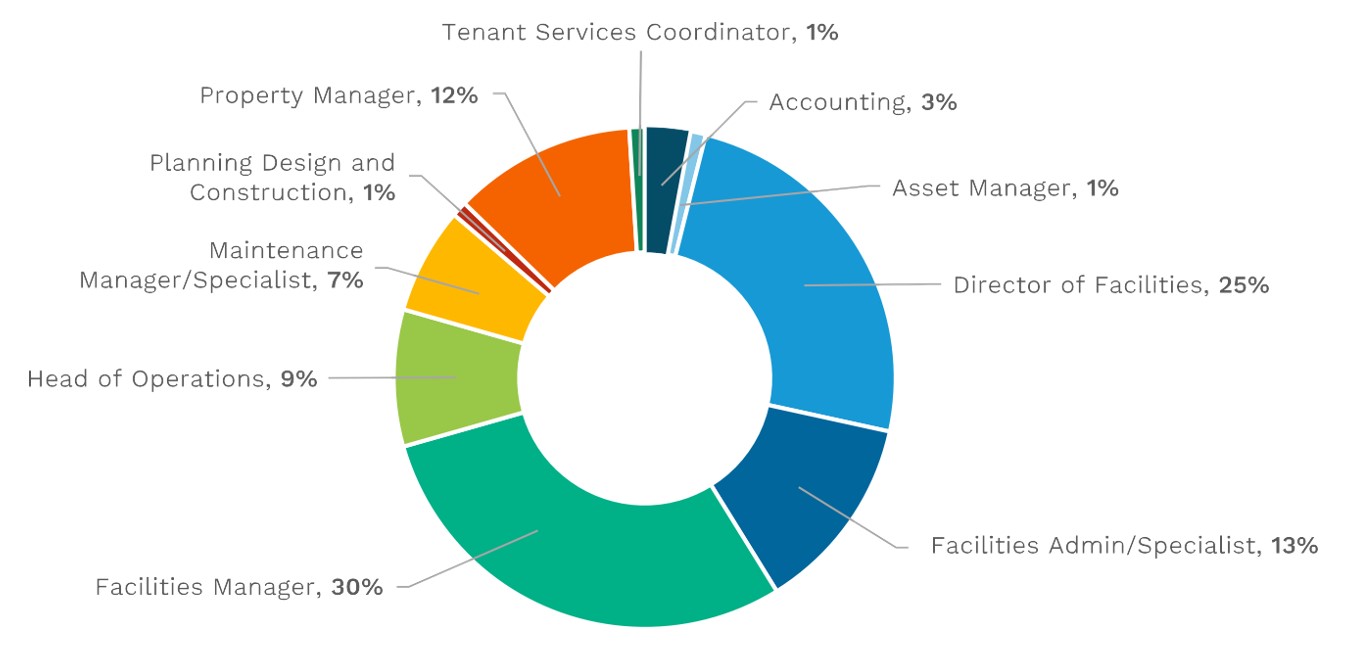
About the survey
MRI Software conducted a survey of facility management professionals during December 2024 and January 2025. More than 100 facilities management professionals responded to the survey.
How would you best describe your industry?
Facilities Management is the only department other than payroll that directly impacts the performance of every single employee in every single department, from the bottom to the top, every single day.
Workload and responsibilities, job satisfaction, and technology
Workload and responsibilities
Expanding responsibilities and increased workload reflect the growing strategic importance of FM for real estate. In the last three years, facility managers have taken on more responsibilities, but operating budgets have increased at a slower pace.

Responsibilities
81%
said their responsibilities have increased over the last 3 years.

Operating Budget
62%
said their operating budget had increased during the same period. 18% stated that it had decreased

Workload
58%
either far too busy or on the busy side.

Overtime
54%
are putting in an additional six to 20 hours beyond their regular schedule.
Job satisfaction
Despite heavier workloads, most respondents were satisfied with their job security and the flexibility of their role. Room for improvement exists around technology and opportunity for advancement.
74%
are satisfied with their job security.
 78%
78%
are satisfied with the flexibility of their role.
 50%
50%
are happy with their opportunities for advancement, and only 8% indicated they were “very dissatisfied”.
Technology
As expected, most respondents are using multiple systems to manage facilities, including a combination of software and spreadsheets. Sixty percent are satisfied with the technology their team uses; however, only 13% were “very satisfied.”
46%
Use multiple systems for facilities management
36%
A combination of software and spreadsheets
A diverse tech stack: Top technologies used for managing facilities
- Facilities Management software
- Energy Management
- Self-service apps for end users to submit requests
- Incident reporting software
- Contractor management
- Space planning
- Dashboarding tools
- Leasing software
- Visitor management software
- Artificial intelligence (AI)
- IoT
- Location analytics for pedestrian and vehicle traffic
Spotlight: Energy management software usage
Of all the trends impacting the industry, energy management software ranks as the most essential to embrace. It’s also the second-most popular software used by facilities management professionals, indicating a clear need to tackle inefficient utility usage and keep costs under control.
Based on the survey data, organizations of all sizes are using energy management software to a similar degree. A variety of FM roles use the software, including facilities managers and directors, property managers, operations leaders, and maintenance managers. The widespread use of energy management software across all organization sizes indicates that the primary focus is on operational efficiencies and cost savings.
45%
of enterprise organizations.
40%
of medium-sized companies.
42%
of small businesses.
Adoption of AI and IoT
Interestingly, artificial intelligence (AI) and IoT rank lower on the list of technologies currently being used, but they rank in the top three opportunities for the industry. This implies that FM teams understand the value of AI and IoT, but barriers are preventing adoption, such as budget constraints, incomplete AI strategy, or lack of tech acumen.
Use of AI technology

More large organizations see AI, IoT, and connected devices as essential to embrace compared to medium and small businesses; however, medium-sized businesses are currently leading the way for AI adoption.

Facilities and operational control without limits
Challenges of the FM role
FMs appear to be doing more with less, given that responsibilities have expanded but budgets have not kept pace. Navigating budget constraints ranks as the number one challenge of working in FM.
Top challenges of the job
- Navigating budget cuts
- Demands of managing aging equipment/infrastructure
- Managing the workload
- Keeping up with preventative maintenance
- Workforce management / Managing contractors (tie)
- Dealing with current technology
- Creating a sustainable workplace
- Dealing with experienced colleagues leaving
- Technology acumen of your team
Many of these challenges are related to business management processes and systems that the FM team doesn’t have complete control over. Challenges with technology and equipment are likely related to broader business challenges, such as budget or resource limitations.
Decisions around budget cuts are driven by a company’s financial situation, and all affected departments must adjust accordingly – including FM. Struggles with increased workloads, workforce management, and managing contractors are often the result of business decisions that directly impact technology usage and the role of facilities management in the organization.
FM is intertwined with the larger business, and FM leaders need to make sure they have a seat at the table when decisions are made. The function of FM impacts all areas of a business, and likewise, changes in the business will impact FM’s ability to support the needs of the organization, its employees, and clients.
Industry challenges and opportunities
New regulations and leveraging advanced technologies, including AI and IoT, present both challenges and opportunities for the future of facilities management.
Top FM industry challenges
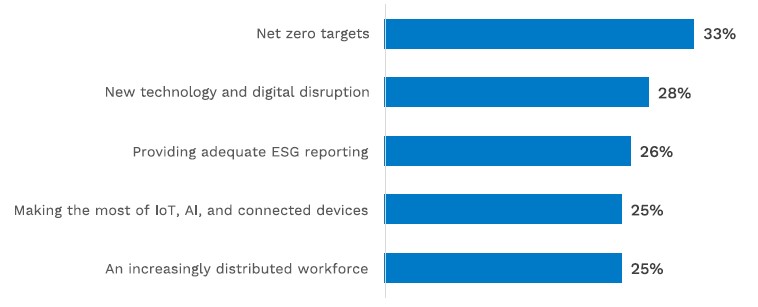
Top FM industry opportunities that are essential to embrace
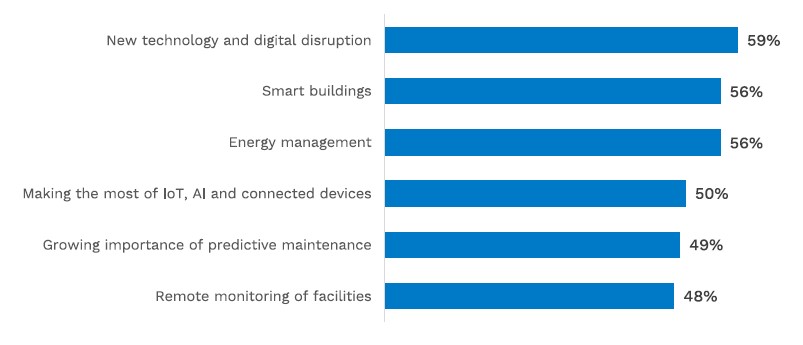
Technology is the key to new industry opportunities
These trends represent a balance between opportunity and challenge – a potential crossroads for the industry, as several trends fall into both categories.
Notably, all the opportunities identified as “essential to embrace” are related to applying the right technology solution to best enable business processes.
Before FM teams make the leap to adopt fully functional AI solutions, it’s crucial to define a long-range digital strategy. This involves evaluating the vast CRE tech landscape to find reliable and accepted technologies that can be integrated into the current tech stack. Additionally, it is important to determine which new technology investments are the optimal fit to support the organization’s mission. Embracing the power and benefits of the “right” technology presents both an opportunity and a challenge for CRE organizations.
As the responsibilities of facilities managers expand, it’s critical that technology evolves to support them.
Top 4 opportunities for the industry
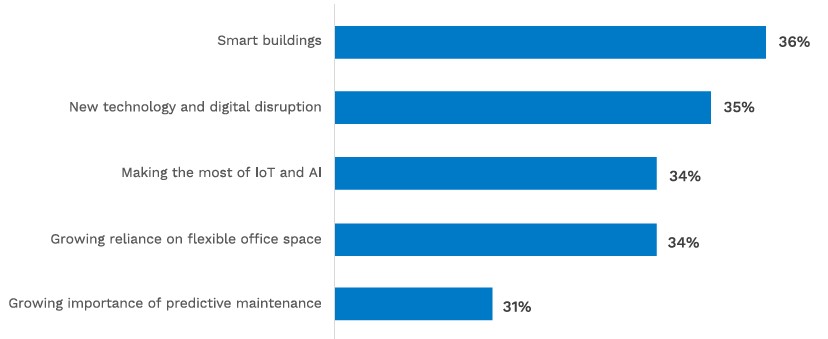
Respondents consistently state that technology-related trends are the most important opportunities for the industry. Technology initiatives go hand in hand in addressing the top industry challenges, such as net zero targets, digital disruption, ESG reporting, and leveraging AI and IoT. However, broader business challenges like budget cuts, aging equipment, and busy workloads present the most likely obstacles to exploring new technology. FM teams have an opportunity to advocate for themselves, highlighting their value to the broader business and taking part in decisions that affect technology budgets.
Trends with the least perceived impact on the industry
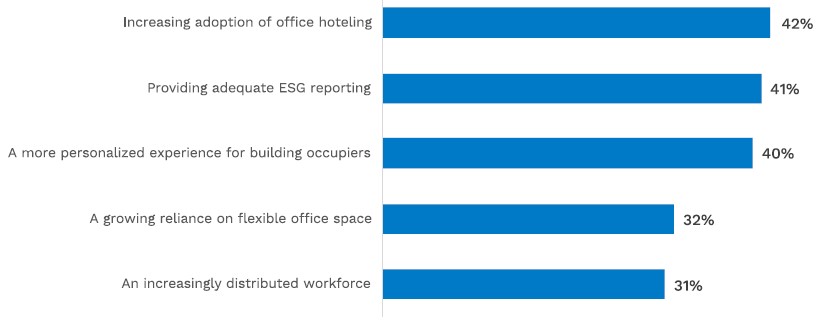
Hybrid work arrangements and flexible workplace initiatives were expected to be disruptive for facilities management; however, the survey data shows that new trends and regulations, such as increased adoption of office hoteling, are having a lower impact than anticipated.
The ability to provide adequate ESG reporting is likely hindered by the absence of uniform data standards. Without standardized data, businesses face challenges in accurately measuring and comparing energy consumption across different buildings – making it difficult to meet reporting and compliance requirements. Using OSCRE energy standards and guidelines offers a helpful blueprint for gathering data from disparate sources and across multiple systems and could prove beneficial as standards mature.
Future of the industry
Key finding:
In the next five years, most respondents expect to see a significant increase in the use of smart technologies and automation, followed by a greater focus on data-driven decision making.
Insight:
The ability to fully leverage smart technologies and automation is contingent on increased investment in AI, IoT and connected devices. Survey respondents ranked smart buildings as the number one opportunity for the industry, but technology initiatives must align with the overall business strategy to be successful. In the next few years, data-driven decision making will become a business imperative, accelerating the implementation of data governance strategies and technology investment.
Interestingly, 37% of respondents expect sustainability to become a central focus but only 12% expect more integration of ESG goals. This implies that sustainability programs are primarily driven by efficiency and cost control. By focusing on operational aspects, these initiatives can provide deeper insights into energy consumption patterns, contributing to financial benefits while also promoting sustainable practices and resource optimization. As a result, organizations can make more informed decisions and realize increased cost savings.
Areas of evolution over the next five years in FM
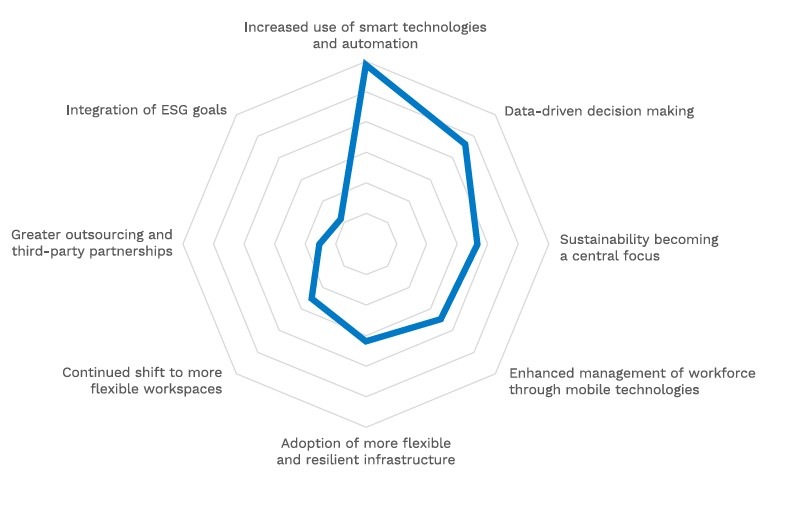
A positive outlook: Commitment to the industry
Of those surveyed, 70% would recommend working in FM, despite the increase in workload and future challenges.
82%
see themselves working in the industry in three years’ time.
70%
would recommend working in facilities management to a friend or colleague
Overall, facilities management professionals take pride in their work and embrace the responsibility that comes with their pivotal role in the organization. Many respondents stated that their role is broader and more complex than they expected — efficient communication and collaboration is essential, particularly when working with different departments such as accounting, finance, HR, IT, vendors, and even tenants. Organizations that recognize the strategic importance of the FM function and embrace technology to support it will be better equipped to enhance
operational efficiency, improve tenant experiences, and drive long-term business success.
An essential career in a fast-growing industry
The high likelihood of recommending the profession is encouraging, but the industry must plan ahead to attract and retain new talent. With half of respondents aged 46 or higher and the increasingly technology-driven nature of the field, there is a pressing need to ensure a steady pipeline of skilled individuals.
The industry needs enhanced promotion of the FM profession to high schools, trade schools and colleges/universities to bring more people into the field.
Survey respondent
There’s no shortage of opportunity for FM professionals in the rapidly growing industry. The North American market is projected to reach $578.3B by 2030 – a 52% increase from 2022 – according to Fortune Business Insights.
Raising the profile of FM as a promising career and increasing awareness to students and younger professionals will be key to sustaining the industry’s growth and innovation.









